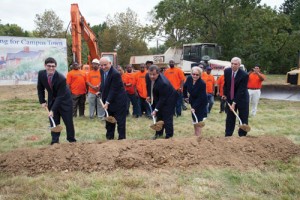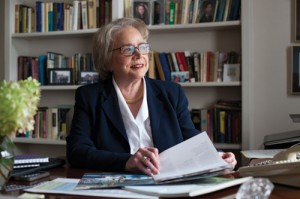A time to be bold
President R. Barbara Gitenstein discusses the challenges facing TCNJ and shares her plans for the years ahead.


In her annual state of the campus speech at the start of this academic year, President R. Barbara Gitenstein stated, “TCNJ is in an enviable position, but we have many challenges ahead.” She assured the members of the campus community who were in attendance that the College would be “bold” in its response to those challenges, adding, “This is not the era for timidity.”
As Gitenstein concludes her 15th year as president of TCNJ, she sat down with TCNJ Magazine to talk about the challenges that lay ahead for the institution and share her vision for how the College will overcome these hurdles while not losing sight of its stated mission to be “a national exemplar in the education of those who seek to sustain and advance the communities in which they live.”
Thank you for meeting with us today. Let’s get right to it. What are the most daunting challenges facing the College right now? And how can and will TCNJ respond to them?
The first challenge you’ll often hear people mention is money. The budget model for public higher education is threatened because our partner, the state, is no longer a consistent and generous partner. That’s true all across the country. Yet I don’t think that’s the biggest challenge we face. The biggest threat to TCNJ, and to its sister institutions, is the general public’s growing suspicion of, and lack of confidence in, higher education. The public is beginning to question whether colleges are worth their investment. They’re fearful that higher education leaders don’t care about costs; that it’s easy for us to just raise tuition; that we really do live in that ivory tower.
The most important thing TCNJ can do in responding to those challenges is to preserve quality. We can’t be so driven by fear of the first question—where is the money coming from?—that we forget the second is the more important one to answer—how do we assure people that what we are giving them is valuable? Because if people believe that something is of value, they will support it; they’ll figure out a way to pay for it. We’ve seen that with regard to healthcare, and I think the same thing is true for higher education.
How, then, does TCNJ prove its value to the general public?
I think student outcomes offer the best proof of the value we offer, particularly with respect to time to degree. Parents are starting to realize the question they should be asking is not ‘How much is tuition in a year?’, but rather, ‘How much is tuition for my child to get a degree?’ Time to degree really matters. TCNJ’s six-year graduation rate is 86 percent, and its four-year graduation rate is 74 percent—that’s fifth highest in the nation among public institutions.
This means that even if we cost more in one year than some schools, our students graduate more quickly so they’re spending less money to get their degree. That means we’re cheaper.

Furthermore, because students received their degrees sooner, they enter the workforce sooner—enhancing their lifetime earnings. Other indications of the value we provide can be seen in our students’ pass rates on national exit and licensure exams, which are often 30 to 40 percent higher than national averages, and our placement rates after graduation, which were 97 percent for the Class of 2012, the most recent year for which data was available. These indicate that not only are our students graduating on time, they’re getting into their professions quickly and doing very well.
One area I think we can improve is doing a better job of showing the community how much we contribute to the region. In terms of our financial impact, the College has a $120 million budget, almost all of which is invested in our faculty and staff, many of whom live in the surrounding community and frequent local businesses. Many of our 6,500 students are also regular patrons of community businesses. That combined spending by TCNJ faculty, students, and staff stimulates the local economy.
But in addition to that monetary investment, the College has made a social investment in terms of our students’ involvement in the local community. We see it not only with the Bonner Scholars, who contribute so much to Ewing and Trenton, but also with the thousands of students who participate in community engaged learning service activities throughout the year. That’s good work: it’s good for the community, and it’s good for our students, too.
Looking ahead, what initiatives are on the horizon that will allow TCNJ to continue to be a valuable partner to the community?
In terms of our social investment, I see our community engaged learning activities continuing to grow. And in terms of the financial, I think the Campus Town Project is going to have a tremendous impact on the community. The developer will be paying the township an annual payment in lieu of taxes, which will escalate with the consumer price index. Also, the retail shops in the complex will be paying taxes. And once the project is complete, there will be all sorts of new and enhanced amenities for the township including a large bookstore, shops, and restaurants.
You said earlier that the budget model for public higher education is broken. Can you explain what you mean? How has the state not held up its end of the bargain?
When I came to TCNJ in 1999, the state supported the College’s operations at about 60 percent; that figure is now less than 27 percent. We have no reason to expect this downward trend to reverse itself in the near future, so something has to change.
Then where does that leave TCNJ? It’s not getting any less expensive to provide the type of educational experience that the College does. With ever-declining state support, how can TCNJ ensure it has the financial resources needed to further its mission?
First, I think we can become less expensive—but not in the way people think about tuition. As I indicated earlier, we can move students through their programs more quickly. So I think we need to look at expanding our offerings. There is a conversation going on right now about changing the class schedule grid to increase class offerings, providing students with more opportunities to take more classes. We’re looking at expanding our J-Term [winter session], which would mean more courses and more opportunities for students to gain credit in a shorter period of time. We need to look at expanding summer school for the same reason.
We also need to look at expanding the use of technology for blended learning. Although we won’t become a distance education institution, there are ways for students to do some portion of their education remotely. Our faculty have been teaching with a blended learning format for some time. We just haven’t institutionalized it or provided enough support for others who want to try it. I think that technology has huge potential for saving on administrative costs; we just haven’t used it as effectively as we could.

Second, while we don’t know how many dollars to expect from the state each year, we can—and we do—make strategic decisions about how we will invest the money we have. I have said before that the College’s greatest financial strength has been its ability to generate solid operating margins despite unstable and declining net state support. Through the years, we’ve done that by being very thoughtful and considered about how we invest our money.
The Board of Trustees has approved a set of metrics with regard to how the College can spend its money. At least 67 percent must be put toward our primary purpose—that means supporting students. No less than 10 percent and no more than 16 percent of our operations go to institutional support of scholarships. Additionally, the Board approved a metric that at least two percent of the budget must go to strategic, mission-based initiatives. This ensures that we’re moving ahead.
Finally, I think we’re going to have to find ways to diversify our revenue streams—to bring in resources other than tuition dollars. The programmatic diversification I spoke of will help in these efforts. With funding from TCNJ Foundation, we’ll be adding a part-time grant writer to help increase the money coming into the College to support the things faculty and staff want to do. We have already seen an extraordinary upgrading of the College’s advancement efforts since Vice President John P. Donohue came on board in October 2012. During his first year here, in the midst of transition, the division exceeded its fundraising goals, and our endowment realized a net increase of $3.8 million.
Will the College look to increase its enrollment of out-of-state and international students as a means of generating revenue?
TCNJ will always be primarily a New Jersey state school. Our New Jersey enrollment could drop to 85 percent and we would still be preponderantly New Jersey citizens. But right now we’re at 95 percent from New Jersey. Consider the amount of revenue that an extra 10 percent of out-of-state and international students could bring to the College.
More significantly though, consider the exciting additional enrichment to the community and the differences of opinion that that would bring. Students have told me they’re very interested in seeing more out-of-state and international students sitting next to them in the classroom, and we’re already seeing a positive trajectory in such enrollments, particularly with respect to international students attending the College.
While we’re on the topic of diversifying enrollment, earlier this semester you said TCNJ must improve its recruitment and retention of students, faculty, and staff from underrepresented populations. Why is this so critical to the College’s mission, and how will TCNJ answer this challenge?
The primary reason it’s important is because it’s the right thing to do. But it’s also important for purely practical reasons. The population is changing. We’re a public institution in one of the most diverse states in the nation. Shouldn’t we embrace that? If we’re going to serve the state, then we have to be inclusive and make sure that people from all backgrounds feel comfortable here.
We have seen some encouraging progress in terms of the number of applications we receive from underrepresented groups, but we haven’t seen that same progress in terms of enrollment. Therefore we have to think through why more students from underrepresented groups who are applying are not choosing to enroll. We have started gathering the data, and once we have it, we’ll begin to figure out specific strategies to address the full range of issues associated with recruiting and retaining a more diverse student, faculty, and staff community. I’m confident that what will happen is that as our numbers in these areas increase, a critical mass will be created and it will become easier.
Let’s shift gears and talk about upcoming changes to the campus’ physical plant. During the next five years, more than $200 million of capital construction will be taking place on campus. Part of that will be Campus Town, which you already mentioned. What excites you most about that project?
 There are certain things that I know students and young alumni want that we cannot afford to build: more housing, non-academic socializing space, an enhanced fitness center. This legislation [the New Jersey Economic Stimulus Act of 2009, which made possible the public-private partnership between TCNJ and The PRC Group, Inc.] allows us to do that without investing any of the institution’s money. That’s a great thing. Furthermore, it’s a great message to the public that, as we’re building these kinds of projects, we’re using neither tuition nor state dollars. In our case, The PRC Group is providing all of the dollars to fund this project. And why are partners, like PRC, involved? Because they’re going to make money from it—and we want them to. It’s a win-win situation.
There are certain things that I know students and young alumni want that we cannot afford to build: more housing, non-academic socializing space, an enhanced fitness center. This legislation [the New Jersey Economic Stimulus Act of 2009, which made possible the public-private partnership between TCNJ and The PRC Group, Inc.] allows us to do that without investing any of the institution’s money. That’s a great thing. Furthermore, it’s a great message to the public that, as we’re building these kinds of projects, we’re using neither tuition nor state dollars. In our case, The PRC Group is providing all of the dollars to fund this project. And why are partners, like PRC, involved? Because they’re going to make money from it—and we want them to. It’s a win-win situation.
You said ‘these kinds of projects.’ I assume you’re referring to the proposed changes to the Brower Student Center?
Yes. That project, which will include a transformative renovation of the interior and exterior of the Student Center, as well as the construction of a 25,000 square foot addition to the building, is being funded through a $30 million investment made by our campus-dining partner. So again, we’re not using tuition or state dollars to enhance our facilities.
And why are these two projects so critical to the College’s future?
A residential campus needs to offer amenities that keep people on campus, because that creates a sense of community. Campus Town and the Brower Student Center project will enhance the living-learning environment at TCNJ, providing facilities and inviting spaces where the students can continue their educational experience outside the classroom.
Another major construction project about to get under way is the STEM Complex. The College will receive $57.4 million in state funding to bolster STEM initiatives on campus. Why STEM?
One of the things that I’m always fearful of is building up facilities and employee bases around something that’s a short-term need. STEM is not going to be a short-term need. There is no question that this country needs more students studying and graduating from the STEM disciplines.

The majority of the state funding that we’re receiving will go toward the construction of a new STEM Building. We’re not building this because we hope to have good STEM programs. We already have fabulous STEM programs. The competitiveness of our biology and chemistry programs is amazing, and our outstanding engineering program is growing tremendously. So we’re building on success here, and we’re giving these already strong programs the support and facilities they need and deserve.
But while we’re growing, we’re doing so conservatively—and we’re being very careful not to overbuild. We won’t be adding thousands of students the way some of our sister institutions are, because we’re most interested in making sure our students graduate—not merely in that we enroll them.
It sounds like you’re optimistic that TCNJ can continue offering a first-rate education despite the many challenges it faces. What would you say to the College’s various stakeholders to assure them of this, so that they will want to continue their connection with TCNJ in the coming years?
If you’re looking to excite people into thinking about investing—whether you’re talking about a parent, a student, a donor, a foundation, or the state—you have to be talking about something that’s successful. The College of New Jersey is doing extremely well. All you have to do is look at our third-party endorsements to know that. I realize these don’t capture everything we do—they don’t convey the value we provide to our students, the community, and the region. However, it’s pretty nice to be one of only 85 institutions, only five of which are state supported, considered “Most Competitive” in the country. I’m proud of that. We all should be.
Interview by Tony Marchetti
Photos by Benoit Cortet, Don Hamerman, and Double Exposure Photography
Posted on December 11, 2013

